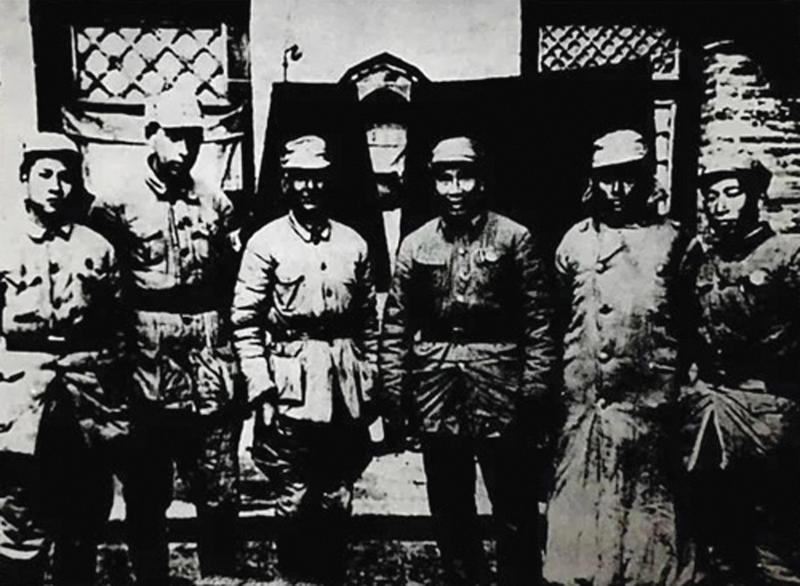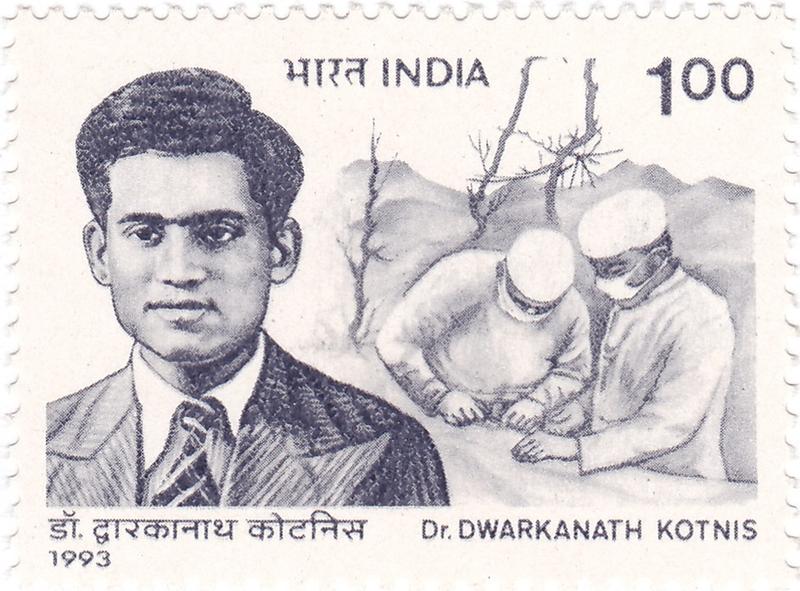 Group photo of Zhu De and members of the Indian Medical Team to China including Kotnis (second from right). (PHOTO / XINHUA)
Group photo of Zhu De and members of the Indian Medical Team to China including Kotnis (second from right). (PHOTO / XINHUA)
A movie in India made in the 1940s about the life of a young Indian doctor who went to China to selflessly treat the injured soldiers fighting against Japanese invaders was popular among Indian people. Seventy-five years have passed since that black-and-white feature film made it to theaters, and there is now another movie in the making about the medical legend.
Indeed, there is a lot to tell about the life and times of Dwarkanath Kotnis, with many stories about his work collected from researchers and ordinary people back in China.
Dr Kotnis’ glorious services to mankind must inspire more than 2.7 billion living on both sides of the borders. He sacrificed his life not just for the wounded Chinese but for humankind
Srikant Kotnis, 98, a cousin of Dr Kotnis, in a message to China Daily
“He helped his patients with food. He was careful and quick while changing dressings so that the wounded wouldn’t feel too much pain. He gave his horse and hat to patients on the march,” said Lou Yue, a research fellow with the North China Martyrs’ Memorial Cemetery.
The Indian doctor, also known by his Chinese name Ke Dihua, worked so hard that during one particular battle in China, in 1940, he performed operations for up to 72 hours and treated more than 800 patients in 13 days.
For the soldiers of the Eighth Route Army and the villagers, the efforts of Kotnis won him the nicknames “Dr Thoughtful” and “Old Ke”, a way the Chinese used to refer affectionately to their friends.
“Dr Kotnis wasn’t just a dedicated, passionate and competent doctor, he was also an exemplary internationalist,” said Rajendra Jadhav, chairman of Dr Kotnis Memorial Committee in Mumbai, India’s financial capital.
“That he is so deeply revered in China, even today, is a testimony to the dedication with which he nursed and treated wounded soldiers of China more than eight decades ago.”
Srikant Kotnis, a cousin of Kotnis, has sent a message to China Daily through Jadhav. “Dr Kotnis’ glorious services to mankind must inspire more than 2.7 billion living on both sides of the borders. He sacrificed his life not just for the wounded Chinese but for humankind,” Srikant Kotnis, 98, said.
“The upcoming movie should capture the true spirit and values Dr Kotnis upheld.”
Dwarkanath Kotnis was one of five Indian physicians in a team sent to China to provide medical assistance in 1938, one year after China began a full-scale resistance against the aggression of Japanese invaders.
Earlier, Communist General Zhu De had requested the British colonial administration in India to send physicians for providing medical assistance to Chinese soldiers.
“At that time, China was in tremendous difficulty,” Lou, who spent years studying the life of Kotnis, said in an interview.
“We had an acute shortage of practitioners and medicines,” she said.
Like Kotnis, each of the other four doctors in the medical team had a Chinese name ending with “hua”, the character meaning China. Among the five, all, except Kotnis returned to India.
 Postal stamp of Kotnis released by the Indian government. (PROVIDED BY DR KOTNIS MEMORIAL COMMITTEE, MUMBAI)
Postal stamp of Kotnis released by the Indian government. (PROVIDED BY DR KOTNIS MEMORIAL COMMITTEE, MUMBAI)
Born to a middle-class family in India’s western state of Maharashtra on Oct 10, 1910, Kotnis graduated from Seth G S Medical College of the University of Mumbai in 1936. He was 28 when he came to China.
Before leaving for China, the team had heard that the Communist Party of China was different from the Kuomintang, and therefore when they arrived, they asked to go to the CPC-led battlefield behind the enemy lines, and work where the Chinese people suffered the most.
With unrelenting persuasion, in 1940 Kotnis finally arrived at the Shanxi-Chahar-Hebei border region to be part of the Hundred-Regiment Campaign, and moved to Gegong village of Tangxian county in Hebei province, becoming a battlefront doctor, performing surgeries on the firing line.
Fighting shoulder to shoulder with CPC members and the Eighth Route Army, “Old Ke” became well-known in the region and fully blended in with the struggle and life of the liberated areas.
For Kotnis, the CPC-led war against Japanese aggression was a great, revolutionary fight for justice, and the Eighth Route Army was like an excellent university turning out tens of thousands of revolutionary youths. He also found out that the anti-Japanese base areas led by the CPC were totally different from the Kuomintang-controlled areas.
“Despite hearing news of his father’s death, he did not return to India. Instead, he reaffirmed his commitment to continue his work in China,” Mrigendranath Gantait, president of the Dr Kotnis Memorial Committee in West Bengal, India, once said after a tour to China.
In 1941, Kotnis was appointed director of the Dr Bethune International Peace Hospital, named after the famous Canadian surgeon Norman Bethune who made valuable contributions to the Chinese people. After the appointment, he performed about 2,000 operations.
“Dr Kotnis swore by the tomb of Dr Bethune, ‘I will live a life as yours’,” said Lou. “He lived up to his oath.”
Kotnis, who learned to speak fluent Mandarin, also taught medicine to Chinese students.
When a student graduated, the doctor would write something to encourage him: “Study hard for the sake of the liberation of the oppressed mankind” in English, and “Victory in the war of resistance against Japan” in Chinese.
Without textbooks, Kotnis would compile them himself.
On the evening of Dec 8, 1942, when he was writing on page 173 of his second surgery textbook, he collapsed, with the pen leaving a long line on the paper. He later died of epileptic seizures at the age of 32.
Though he was a CPC member for only three months, Kotnis dedicated himself completely to the cause he believed in.
“He made his highest sacrifice by giving his life for the cause of the Chinese peoples’ liberation movement,” said Gantait.
Late Chinese leader Mao Zedong was deeply affected by Kotnis’ death. Mao wrote in his eulogy that “the army has lost a helping hand, the nation has lost a friend. Let us always bear in mind his internationalist spirit”.
In China, Kotnis fell in love and married a Chinese nurse who worked with him. The woman, Guo Qinglan, gave birth to their son less than four months before the doctor’s death. The boy was named Yinhua, two Chinese characters literally meaning “India” and “China.” Unfortunately, Yinhua died in 1967 at the age of 24 as a result of medical malpractice, shortly before graduating from medical college.
Nearly eight decades after the passing of Kotnis, the memory of the Indian doctor continues to be cherished in China.
In China, apart from a school named after him — the Shijiazhuang Ke Dihua Medical Science Secondary Specialized School, there are memorials of Kotnis in both Shijiazhuang, the capital of Hebei province, and Tangxian county where he once worked.
Kotnis is such a towering and respected figure in China that when Chinese leaders visited India, they made it a point to visit or send flowers to Kotnis’ relatives.
Jadhav of the Dr Kotnis Memorial Committee in Mumbai fondly recalled the day Chinese Premier Li Keqiang met the family of Kotnis on May 22, 2013, during a visit to India. Li had a chat over a cup of tea with Manorama, Kotnis’ nonagenarian sister, during the trip.
“She was visibly touched by the warmth displayed by the Chinese premier,” said Jadhav, who had received the Five Principles of Peaceful Coexistence Friendship Award from Chinese President Xi Jinping in 2014 in recognition of his commitment to China-India friendship.
In 2006, the then Chinese president Hu Jintao met Kotnis’ relatives, including his two sisters, while paying rich tributes to the Indian doctor, describing Kotnis as “a bridge between China and India”, according to government records.
The sacrifice and valor shown by Kotnis during his time in China continues to inspire the third generation of his family members, as well as Indian doctors, film makers, and numerous other admirers.
Almost 79 years after his death, Kotnis’ fans in India believe that if the doctor’s selfless services are properly portrayed to the new generation, it can help bridge the gap and promote understanding between India and China.
North Court High School in Solapur, Maharashtra state, where Kotnis did his schooling has maintained a century-old register of Kotnis’ enrolment in the school.
In 1976, a railway medical facility in the city of Solapur in Maharashtra state was named the Dwarkanath Kotnis Memorial Hospital.
Kartik Kendhe, an Indian film director has started to make a film on the life of Kotnis, in Marathi language. The film will have English and Chinese subtitles to spread the story of the Indian doctor who devoted his life to saving wounded Chinese soldiers.
A part of the film will be shot in China’s Hebei border region. The goal of the film is to remind everyone of the Sino-Indian friendship built by Kotnis, said Kendhe.
Jadhav, from the Dr Kotnis Memorial Committee, is palpably excited about the new movie.
“I only hope that Friend of Mankind, the bilingual biopic in Hindi and Chinese, would inspire the peoples of China and India alike. These two countries are among the oldest civilizations in the world,” he said.
In order to build strong cultural ties between China and India, on April 3 this year, on the occasion of Qingming Festival, the Chinese Consulate in Mumbai and Dr Kotnis Memorial Committee jointly held an online memorial event for Kotnis.
Kotnis is “a hero to remember, a monument to eternity”, China’s ambassador to India, Sun Weidong, said on the doctor’s 110th birth anniversary last year.
Experts have on many occasions suggested that the two countries should highlight Kotnis’ legacy to enhance their mutual cooperation, noted Swaran Singh, a professor who is chairman of the Centre for International Politics, Organization and Disarmament at Jawaharlal Nehru University, New Delhi.
Xinhua contributed to this story.


